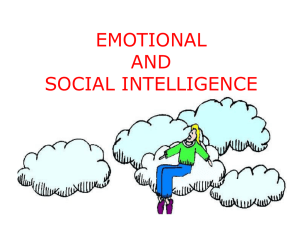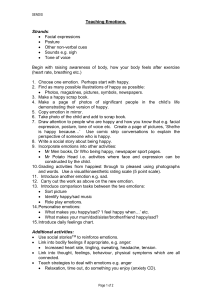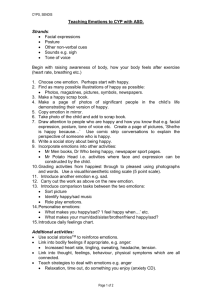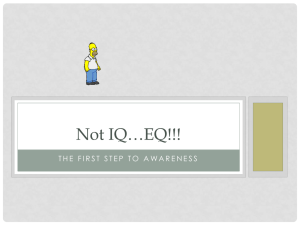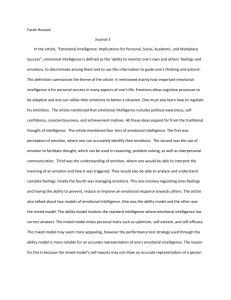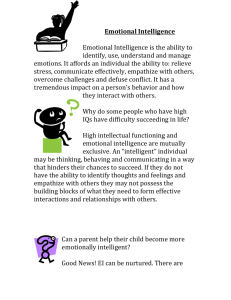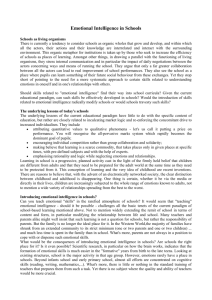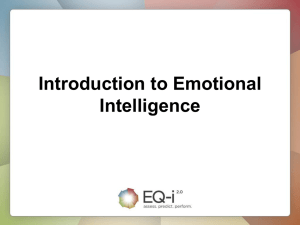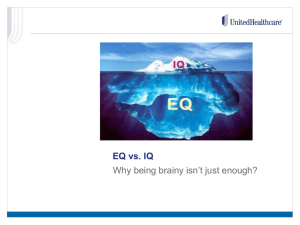Emotional Intelligence (EI) Lecture Slides
advertisement
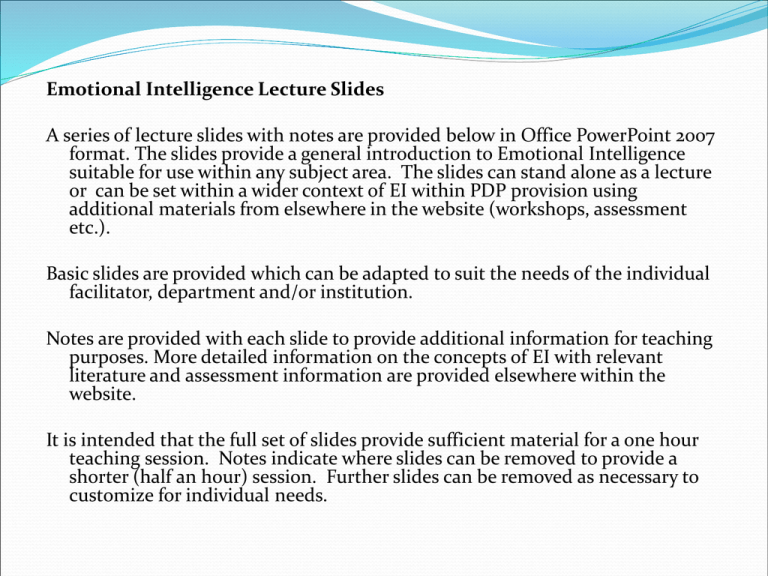
Emotional Intelligence Lecture Slides A series of lecture slides with notes are provided below in Office PowerPoint 2007 format. The slides provide a general introduction to Emotional Intelligence suitable for use within any subject area. The slides can stand alone as a lecture or can be set within a wider context of EI within PDP provision using additional materials from elsewhere in the website (workshops, assessment etc.). Basic slides are provided which can be adapted to suit the needs of the individual facilitator, department and/or institution. Notes are provided with each slide to provide additional information for teaching purposes. More detailed information on the concepts of EI with relevant literature and assessment information are provided elsewhere within the website. It is intended that the full set of slides provide sufficient material for a one hour teaching session. Notes indicate where slides can be removed to provide a shorter (half an hour) session. Further slides can be removed as necessary to customize for individual needs. Emotional Intelligence (EI) Insert Facilitator Name and Institution “Anyone can become angry … that is easy. …But to be angry with the right person, to the right degree, at the right time, for the right purpose, and in the right way … that is not easy.” (Aristotle) Overview What is emotional intelligence (EI)? Why is EI important? Why bother to develop EI skills? How can I develop EI skills? What is Emotional Intelligence? “The capacity for recognising our own feelings and those of others, for motivating ourselves, for managing emotions well in ourselves and in our relationships.” (Goleman, 1995) What is Emotional Intelligence? the ability to perceive emotions the ability to access and generate emotions so as it assist thought the ability to understand complex emotions and emotional knowledge the ability to reflectively regulate emotions so as to promote emotional and intellectual growth Emotional Understanding 1 Which of the following faces is expressing happiness, surprise, anger, sadness? A B C D Emotional Understanding 2 Divide into groups of 5. Choose one person to express the facial emotion provided on the list You must sit very still and silent and not move anything except your facial muscles. How many emotions can you correctly identify (out of 20) in 5 minutes? Emotion Regulation 1 You and your partner have got into an argument that has escalated into a shouting match; you’re both upset and, in the heat of the anger, making personal attacks you don’t really mean. What’s the best thing to do? a. b. c. d. Take a 20 minute break and then continue the discussion Just stop the argument – go silent, no matter what your partner says Say you’re sorry and ask your partner to apologise too Stop for a moment, collect your thoughts, then state your case as precisely as you can Emotion Regulation 2 How do you regulate your emotional reactions? Four Basic Components of EI Self awareness Social awareness Self management Relationship management What Does High or Low EI Look Like? HIGH 'I feel...' Open expression of emotions Not preoccupied with negative emotions Can identity the feelings of others Emotionally resilient Decisions based on feelings and logic Accepts self and others Good listener Talks about problems LOW 'You always make me feel....' Cannot share feelings verbally Negative feelings dominate Not perceptive to others' feelings Carries grudges, unforgiving Acts without reasoning or logic Not accepting of self or others Poor listener 'Hits out' when there is a problem EI and Other Psychological Constructs Is EI just a repackaging of other concepts? Emotion regulation Social cognition Personality An umbrella term that encompasses lots of areas of emotional knowledge and control that we have lots of empirical data to support. So Why is EI Important? High EI individuals compared to those low on EI are: Less aggressive More empathic Happier Have fewer unauthorised absences and exclusions from school Less depressed Less stressed Higher self-esteem Less lonely Better quality friendships and sexual relationships Education and High EI Cope better at transition periods Lower drop out from school and university Higher academic qualifications Better career prospects But Can We Change EI? Yes, as the construct encompasses constructs such as emotion regulation and social cognition which we know from the literature are changeable. EI interventions are successful with high school students and those in HE. In the 21st century the most significant challenge for graduates will be to manage their relationship with work and with learning. This requires skills such as negotiation, action-planning and networking, added to qualities like self-awareness and confidence. These are the skills required to be self-reliant in career and personal development, skills to manage processes rather than functional skills.” (Association of Graduate Recruiters, 1995) Our graduates are being judged by a new yardstick (Dudiak & Anderson, 2006) EI training at university can give our graduates the edge! (Dacre-Poole & Sewell, 2007)


